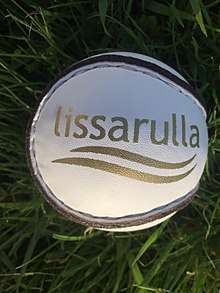Sliotar
A sliotar or sliothar (/ˈʃlɪtər/; Irish: [ʃlʲɪt̪ˠəɾˠ]) is a hard solid sphere slightly larger than a tennis ball, consisting of a cork core covered by two pieces of leather stitched together. Sometimes called a "hurling ball",[1][2] it resembles a baseball with more pronounced stitching. It is used in the Gaelic games of hurling, camogie, rounders and shinty.

Dimensions
An official Gaelic Athletic Association (GAA) sliotar, as used in top level hurling competitions such as the National Hurling League or the All-Ireland Senior Hurling Championships is subject to strict regulations as regards its size, mass and composition.[3]
The following regulations apply:
- The diameter is between 69 and 72 mm (2.7 and 2.8 in) not including the rib[4]
- The mass is between 110 and 120 g (3.9 and 4.2 oz)
- The rib height is between 2 mm and 2.8 mm, and width between 3.6 mm and 5.4 mm
- The leather cover can be between 1.8 mm and 2.7 mm and is laminated with a coating of no more than 0.15 mm
Approved sliotars carry a GAA mark of approval. The GAA maintains a list of approved suppliers, based on manufacturers who pass their inspection.[5]
History
Early (pre-GAA) sliotars used various materials, depending on the part of the country, including combinations of wood, leather, rope and animal hair and even hollow bronze.[6] The etymology is uncertain, with some connecting it to sliabh ("mountain") and thar ("across"), after Cúchulainn's story of hitting a silver ball across a mountain.[7]
In the early years of the GAA, there was no specific standard for the size or weight of sliotars. The man credited with initial standardisation of the sliotar is Ned Treston (1862–1949) of County Galway. He was selected to play in a match between South Galway and North Tipperary in February 1886 in Dublin. Prior the game, there was debate between the teams as regards the size of the sliotar. Treston made a sliotar at a nearby saddler, which was used in the game, and went on to be a prototype for subsequent sliotars.[8]
Johnny McAuliffe (1896–1960) of County Limerick is credited with the modern design. Before his improvements the ball tended to be inconsistent due to poor manufacturing. It was also heavier than modern sliotars (over 200g), and due to being made partly with horse-hair, tended to lose shape during play, and become soggy in wet conditions. The brown colour also meant that the ball was difficult to see in some conditions. McAuliffe's changes introduced a cork core, with a 2 piece white-tanned leather covering as the standard materials. These changes led to a harder wearing ball, which was water resistant and easier to see. The construction materials also meant that the ball was only about half as heavy as Treston's version.[6]
In the early 2000s, the GAA experimented with using sliotars with rubber rather than cork cores; however, it was found that using a rubber core led to a more unpredictable bounce, and moved a lot faster than a ball with a cork core, especially in wet conditions. It was decided to return to a cork ball because of this.[6] While different sized sliotars are used for different ages and codes (with, for example, senior camogie games using a "size 4" sliotar, and senior hurling a "size 5" ball),[9] some claims have historically been made of non-standard balls being used to gain a perceived advantage in competition.[10][11]
References
- "Hurling Balls". oneills.com. O'Neills. Retrieved 29 July 2020.
- "New English-Irish Dictionary - hurling ball". focloir.ie. Foras na Gaeilge. Retrieved 29 July 2020.
- "Gaelic Athletic Association Official Guide - Part 2" (PDF). Gaelic Athletic Association. 2009-06-03. p. 14. Archived from the original (PDF) on 2012-03-06. Retrieved 2012-02-22.
- Gaelic Athletic Association - Official Guide - Part 2 (PDF). gaa.ie (Report). Gaelic Athletic Association. May 2017. p. 16. Retrieved 2 September 2019.
The diameter of the Sliotar - not including the rim (rib) - shall be between 69mm. and 72mm. The mass of the Sliotar shall be between 110 and 120 grams
- "GAA Approved Suppliers". Gaelic Athletic Association. Archived from the original on 2012-01-25. Retrieved 2012-02-22.
- Gormley, Eamon (2006-07-03). "The Science of Sliothars". An Fear Rua. Archived from the original on 2010-12-24. Retrieved 2009-09-16.
- Chetwynd, Josh (May 3, 2011). "The Secret History of Balls: The Stories Behind the Things We Love to Catch, Whack, Throw, Kick, Bounce and B at". Penguin – via Google Books.
- "Hurling in Gort" (PDF). Gort GAA. Retrieved 2 September 2019.
- Camogie-Hurling Rule Differences 2018-2021 (PDF). camogie.ie (Report). Camogie Association. September 2018. p. 2. Retrieved 2 September 2019.
- "New regulations aim to put end to 'codology' over sliotars". irishexaminer.com. Irish Examiner. 1 August 2006. Retrieved 2 September 2019.
- "John Allen: Sliotar dimensions much ado about nothing". irishtimes.com. Irish Times. 13 May 2016. Retrieved 2 September 2019.
.jpg)